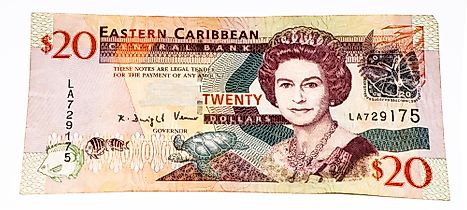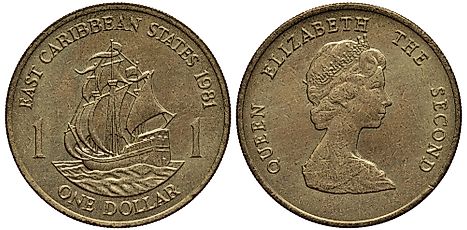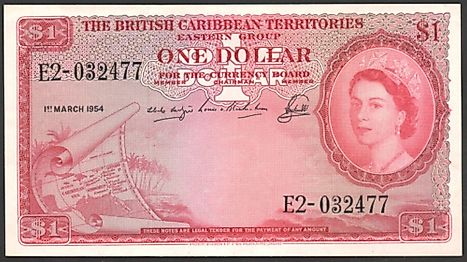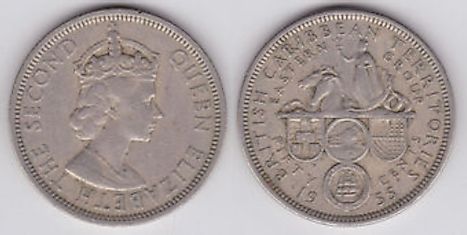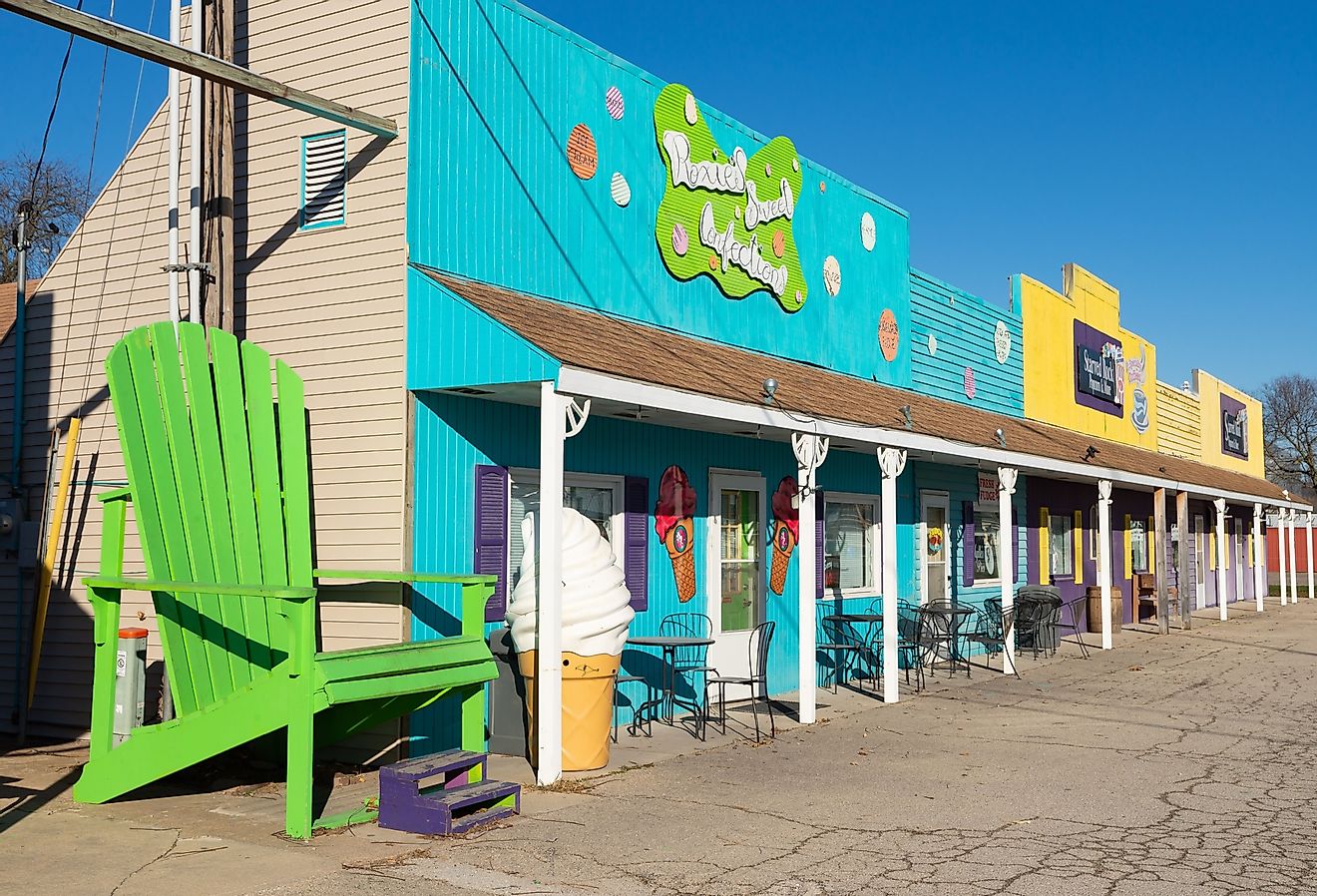Flags, Symbols, & Currencies of Saint Kitts and Nevis
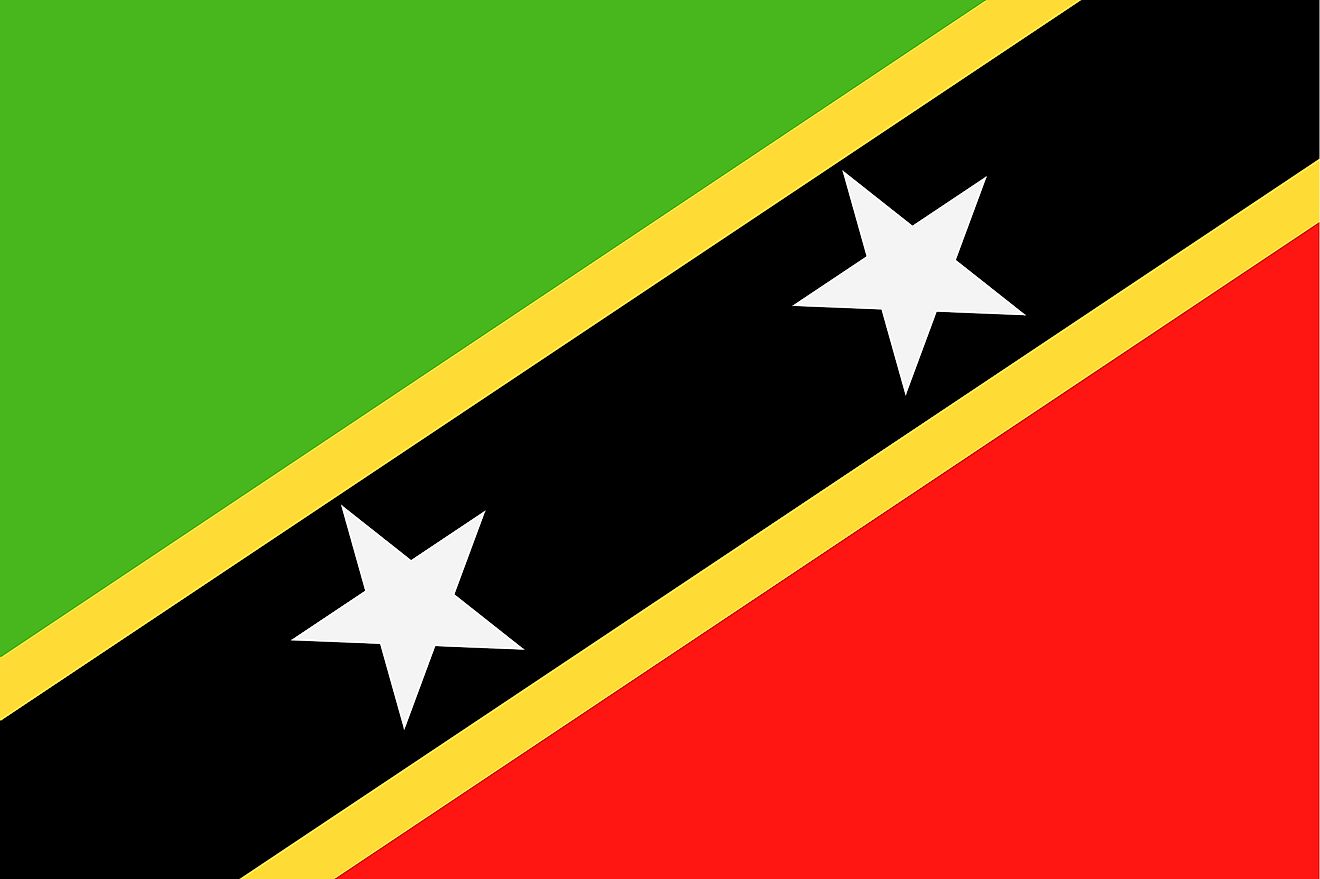
The flag of St. Kitts and Nevis was officially adopted on September 19, 1983. The flag features a black band with yellow edges running diagonally from the lower corner of the flag's hoist-side to the upper fly-side corner. The two resulting triangles at the upper and lower side of the flag are colored green and red, respectively. The diagonal band has two white five-pointed stars on it.
Each of the colors and symbols used in the country’s national flag has symbolic meanings. The green color of the flag represents the nation's fertile land. The red color symbolizes the people’s struggle for freedom from years of slavery and colonial rule. The black color in the flag represents the African origin of the people inhabiting the country. The yellow color epitomizes sunshine. The two stars of the flag symbolize the two islands of Saint Christopher (the formal name of Saint Kitts) and Nevis. The stars also represent liberty and hope.
History of the Flag
After the Federation of Saint Kitts, Nevis and Anguilla collapsed, and Anguilla separated from the union, a new flag was needed to represent unified St. Kitts and Nevis. The previous flag of the federation had to be replaced since its symbols were based on the concept of a union of three. A national-level competition was held to select a flag to represent St. Kitts and Nevis. 258 entries were examined and the design of Edrice Lewis, a student, was selected from among them. The national flag of the country was first hoisted on September 19, 1983, the day when the country attained its independence.
Symbols of Saint Kitts and Nevis
National Coat of Arms of Saint Kitts and Nevis

The Saint Kitts and Nevis Coat of Arms displays the motto "Country Above Self". The center of the coat of arms is dominated by a blue shield bearing several features. At the base of the shield is a sailing ship. Above that is a red chevron highlighted by two poinciana flowers, and at the top of the shield is the head of a Carib indian between a fleur-de-lis and a rose. The Caribs were the early inhabitants of the islands, and the fleur-de-lis and rose signify the English and the French influences. A helmet topped with a tower appears with a flaming torch upheld by the hands of an African, European, and a person of mixed descent. The torch signifies the struggle and quest for freedom by a people of diverse ethnic origins, but united in purpose. The shield is supported on either side by pelicans, displaying a sugar cane plant and the coconut palm tree - which are extensively cultivated throughout Saint Kitts and Nevis.
National Anthem
- Anthem Title: O Land of Beauty!
- Music composer and Lyricist: Kenrick Georges
- Date of Adoption:1983
The national anthem of Saint Kitts and Nevis, known as "O Land of Beauty!," comprises of two stanzas of eight lines each. The first stanza mainly praise the country for its peace and freedom while the second stanza highlights the virtues that the country stands for. The lyyrics were written and set to music by Kenrick Georges. It was officially adopted as the national anthem at independence in 1983
Kenrick Georges
O Land of Beauty!
Our country where peace abounds,
Thy children stand free
On the strength of will and love.
With God in all our struggles,
Saint Kitts and Nevis be,
A nation bound together,
With a common destiny.
As stalwarts we stand,
For justice and liberty.
With wisdom and truth,
We will serve and honour thee.
No sword nor spear can conquer,
For God will sure defend.
His blessings shall forever,
To posterity extend.
The Currency of Saint Kitts and Nevis is the Eastern Caribbean dollar
The Eastern Caribbean Dollar is the official currency in member states of the Organization of Eastern Caribbean States which include Saint Kitts and Nevis. The currency is codified as XCD in international money markets and is abbreviated as $ (or EC$). The currency was introduced in 1965 as a replacement to the British West Indies Dollar. The Eastern Caribbean Dollar is made of 100 subunits known as cents and has been pegged to the US Dollar since 1976 at the rate of 1 US$ to 2.70 EC$. The issuance of the Eastern Caribbean Dollar is conducted by the Eastern Caribbean Central Bank which issues the currency in coinage as well as banknotes with the lowest denomination being the 5-cent coin and the highest being the 100-dollar banknote.
Historical Currencies of Saint Kitts and Nevis
Saint Kitts and Nevis has had other currencies circulation over its history and includes the Eight Royal Coins, the Saint Kitts Dollar, and the British West Indies Dollar.
Spanish Dollar (Eight Royal Coins)
The Spanish Dollar was the official currency of the Spanish Empire which circulated all over the world in the 17th and 18th century. Also known as the “Eight Royal Coins”, the currency was adopted in the West Indies (which included Saint Kitts and Nevis) as the legal tender due to its unique milling characteristics as well as its uniformity in standard. The Eight Royal Coins was issued in coinage and continued being used in circulation on the islands until the late 19th century.
Saint Kitts Dollar
The Kingdom of Great Britain gained control of the islands of Saint Kitts and Nevis with the signing of the Treaty of Utrecht in 1713 in the aftermath of the War of Spanish Succession where the British won at the expense of the French. The British Empire through Her Majesty, Queen Anne proclaimed the establishment of the gold standard in 1701 in the West Indies. However, it took about 150 years for Saint Kitts and Nevis to adopt the sterling currency (Saint Kitts adopted in 1849 while Nevis adopted in 1858). The Saint Kitts Dollar was made of subunits known as bits where one dollar was equivalent to 12 bits and each bit was worth 9 pence. The colonial power issued the Saint Kitts Dollar in coinage where the currency was minted in half, quarter, and eighth-dollar coins. Dollar-denominated private banknotes were issued in 1913 and were later reissued in 1920. The Saint Kitts Dollar was replaced by the British West Indies Dollar in 1935.
British West Indies Dollar
The British colonial power introduced the British West Indies Dollar as the official currency used in its Caribbean colonies including Saint Kitts and Nevis. The currency was adopted in the islands in 1935 and replaced the Saint Kitts Dollar after the Saint Kitts Dollar was affected by the 1873 global silver crisis which led to the demonetization of silver coins. The issuance of the British West Indies Dollar was regulated by the British Caribbean Currency Board based in Trinidad. The British Caribbean Currency Board was later replaced by the East Caribbean Currency Authority in 1965 after Trinidad and Tobago withdrew from the economic body and set up its own central bank. The currency was pegged to the Sterling Pound at the rate of 1 pound to 4.8 dollars. The British West Indies Dollar was primarily issued in coinage of a half-cent, one, two, five, ten, twenty, and fifty denominations with the obverse of all coins bearing the likeness of Her Majesty, Queen Elizabeth II.
